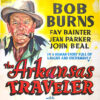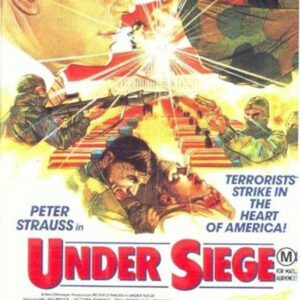calsfoundation@cals.org
Under Siege
The television movie Under Siege was first broadcast over two nights in February 1986. It was filmed in and around Little Rock (Pulaski County) in 1985, with the Arkansas State Capitol standing in for the nation’s capitol building in Washington DC. Today, the movie is notable for its prescient storyline of a suicide terrorist attack by Arab nationals against the U.S. mainland, an idea considered improbable at the time. This movie should not be confused with a 1992 Steven Seagal martial-arts movie of the same title.
The 136-minute film—which, with commercials, filled two ninety-minute showings on two evenings—was billed as a “Special Event Miniseries” on the NBC network. Under Siege was directed by Roger Young, who also directed the movies Into Thin Air (1985), Murder in Mississippi (1990), and Hercules (2005), as well as episodes of the TV series Alfred Hitchcock Presents and Magnum P.I. Bob Woodward (of Watergate and All the President’s Men fame) wrote the script along with Christian Williams.
The screenplay was controversial in 1986. Some said its portrayal of a terrorist assault by Arabs was discriminatory and its premise of suicide attacks on the United States unrealistic. However, at the time, there was also heightened awareness of the potential for conflict with the Arab world due to the Iran Hostage Crisis (1979–1981), which took place only a few years before the movie aired.
In the movie, Iranian-led terrorists launch their attack using truckloads of explosives (as were later used in the World Trade Center bombing of 1993) and airplanes exploding in midair (presaging the use of airliners on September 11, 2001). Targets are multiple locations, including a Washington DC army base, a suburban mall, and a crowded restaurant. The FBI chief, named John Garry in the movie (played by Peter Strauss), believes the terrorist acts are those of a group of militant extremists rather than an organized hostile action by an individual nation.
Administration officials, including senior advisors Harold Sloan and Bernard Hughes (played by E. G. Marshall and Fritz Weaver, respectively), oppose the FBI chief. For various political reasons, they try to pressure President Maxwell Monroe (played by Hal Holbrook) into retaliatory strikes against the nation of Iran, which has not been proven to be responsible for the attacks. Secretary of Defense Andrew Simon (played by Paul Winfield) is the only other presidential advisor urging caution before the United States attacks another country for no confirmed reason. The fictitious president, despite being under pressure to attack, decides to exercise caution until he can be sure of the facts before going to war.
Little Rock was chosen for key scenes because the State Capitol, built between 1899 and 1915, bears a striking resemblance to U.S. Capitol. The Arkansas Capitol was a stand-in during the movie’s fictitious “bombing” of the nation’s capitol building. While the pyrotechnics did not damage the building structurally, burn marks remained on the dome for some time, causing discussion about using the state’s seat of government in a Hollywood role.
Downtown Little Rock was used for street scenes in the movie, and the Interstate 430 bridge was also used in the filming. Pinnacle Mountain State Park west of Little Rock was used to represent the presidential retreat at Camp David. Some local residents were hired for small roles as actors and crew members.
When the movie was broadcast, it aroused moderate interest for its superior acting and production qualities, but the premise of a terrorist attack on the United States was called outlandish. The Emmy nominations for Outstanding Miniseries of 1986 did not include Under Siege, but it did, however, win the Emmy that year for Outstanding Sound Editing.
In 1998, a similar plotline was used in a film called The Siege with Denzel Washington. It was also criticized at the time for its portrayal of Arab terrorists and the theme of America under attack.
For additional information:
“Under Siege.” Internet Movie Database. http://www.imdb.com/title/tt0092132/ (accessed September 14, 2020).
Nancy Hendricks
Arkansas State University
 Arts, Culture, and Entertainment
Arts, Culture, and Entertainment Divergent Prosperity and the Arc of Reform, 1968–2022
Divergent Prosperity and the Arc of Reform, 1968–2022 Movies
Movies Under Siege Poster
Under Siege Poster 




Comments
No comments on this entry yet.